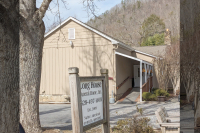The first truly showy woodland flower
Editor’s note: This column first appeared in The Smoky Mountain News in May 2005.
Hepatica doesn’t display the earliest flowers that bloom each year. Those of bitter cress, henbit, purple dead nettle, bird’s-eye speedwell, and others appear in open moist sunny spots by late January or early February. But to my way of thinking, year in and year out, hepatica is the earliest of the truly showy woodland wildflowers. Trailing arbutus has a reputation in this regard. One often reads of those who discover it blooming under late snows. But I hardly ever observe arbutus doing much more than budding before April. Hepatica can still be found in bloom in early May in the higher elevation hardwood forests.
Flowers with stories: Nodding Trillium Garden opens in Cullowhee
No matter what scale of time you’re using, the newly opened Jean Pittillo Nodding Trillium Garden in Cullowhee has deep roots.
“Let’s go back about 400 to 700 million years,” said landowner Dan Pittillo as he began his explanation to the group gathered to experience the wildflower trail’s grand opening April 17.
Smokies ranger earns national award
A National Park Service ranger who has focused on the scientific and educational significance of the Great Smoky Mountains National Park for more than 20 years earned national praise in this year’s Public Lands Alliance awards ceremony, held Feb. 27 in Denver, Colorado.
Susan Sachs, education branch chief for the Great Smoky Mountains National Park, received the 2019 PLA Agency Leadership Award for cultivating and leading partnerships, the result of a nomination from the Great Smoky Mountains Association.
Oil Nut, that most curious fruit
For Elizabeth and me, the fall season is one of the most invigorating times to get out in the woods and prowl around. Many of the most beautiful wildflowers found in the Blue Ridge, especially the lobelias and gentians, are then coming into their own. And most of the others are in their fruiting stages. The transition from flower to fruit (or seed) is both logical and enjoyable. The varied fruiting forms — which run the gamut from drupes, berries, and pomes to follicles, utricles, loments, and legumes to capsules, achenes, samaras, and nuts — are as attractive and intricate in their own way as any wildflower. And they are, after all, the grand finales of the germination-flowering-pollination cycle.
Virgin’s bower is a favorite mountain wildflower
It’s late July and before long summer will be slip-sliding toward autumn. The gap between now and then is often overlooked in regard to wildflowers. The first flaming cardinal flowers appear along the creeks and purple Joe Pye weeds and ironweeds throw up their scraggly heads. The entire countryside will be blanketed in a seemingly endless array of thistle, flowering spurge, evening primrose, mullein, heal-all, mints, goldenrods, asters, and so on.
Wildflower spotting: New book guides search for April blooms
The combination of a stress-filled week and the dawn of a perfect, sunny and 70-something degree day worked like a drug, a magnetic compulsion to leave the dark indoors in search of a sunlight-swathed trail to melt my anxiety away.
Mid-April is standout wildflower season here in the lower elevations of the mountains, so I grabbed the newly minted trail guide sitting on my desk for guidance on where to go. Wildflower Walks & Hikes: North Carolina Mountains, is the latest title from Swain County-based guidebook author Jim Parham, and with 59 hikes organized by location, habitat and peak season, it wasn’t hard to find an outing to match my criteria: low enough elevation to feature April wildflowers, dog-friendly and as close to Waynesville as possible.
The Naturalist's Corner: Spring has sprung
It doesn’t take a calendar to know spring is here. Spring is surely in the air but it’s also in the trees; it’s clawing through the dirt; it’s singing from vernal pools, streams and lakes; it’s even in the heavens.
Orion is chasing Taurus out of sight as we turn away from the bright stars of the winter nights. Ursa Major (big dipper) and Ursa Minor (little dipper) will become prominent features and can serve as pointers for finding the North Star, Polaris, plus a number of summer constellations.
When they bloom, ‘fall’s a-coming’
Late summer has slid into early autumn. The end of summer officially arrived with the autumnal equinox of Sept. 23, when the sun crosses the celestial equator.
One senses this transition in the cool mist-shrouded mornings we’ve been experiencing of late … as well as by the brown-splotched and red-tinged leaves of the buckeye trees. Communal groups of swallows will gather on wires and branches prior to their annual southerly migration. Monarch and cloudless sulphur butterflies will pass with ease over high ridges and through low gaps headed for ancestral wintering grounds.
Stories, salad and wildflowers: Plants a passion for Bigelow
 Adam Bigelow bears down on the gas pedal of his biodiesel-fueled Jetta, urging it up the steep contours of the Blue Ridge Parkway in search of higher ground. It’s a gardener’s car, through-and-through, the dash covered with dried plant parts, the floorboards papered with garden-related fliers and catalogues.
Adam Bigelow bears down on the gas pedal of his biodiesel-fueled Jetta, urging it up the steep contours of the Blue Ridge Parkway in search of higher ground. It’s a gardener’s car, through-and-through, the dash covered with dried plant parts, the floorboards papered with garden-related fliers and catalogues.
The only thing that’s missing is a live plant, and even that’s not too far-flung a reality. It wasn’t that long ago, Bigelow recalls, that he looked down from his seat to see a little pea plant growing up, apparently having received just the right amount of water from some mysterious source to take root in the car.
The “New” Spring Wildflower Pilgrimage
The 62nd Annual Spring Wildflower Pilgrimage in the Great Smoky Mountains National Park will be April 25 – 28. I was curious if this unseasonably warm, early spring was going to have any impact on the pilgrimage so I talked with an old friend about it. Patricia Cox is a botanical specialist with the Tennessee Valley Authority. She was a botany professor at the University of Tennessee, and she is one of the organizers of the Wildflower Pilgrimage. Cox has led hikes at the pilgrimage since 1992.
Cox said that some of the regular pilgrimage crowd pleasers might be gone or nearly gone this year. She said that fringed phacelia was already in bloom in the park in late March and that “…more than likely those large displays around the Chimney’s picnic area will be gone.” But there could be a new pilgrimage poster child crowned.
“I’ve seen lots of photos of Lady’s slippers this week on Facebook, so they will be out for sure next week,” she said. “We haven’t seen yellow Lady’s slippers in flower for the past several years because we were too early. So, while we may not see some of the usual things, I’m excited about seeing the unusual.”
In keeping with tradition, this year’s pilgrimage offers numerous new programs. They include “Traditional Cherokee Plants” with wildcrafter Ila Hatter. Learn how the forests of the Smokies provided for the Cherokee. There will be a reception for Cindy Carlson, “Featured Wildflower Artist.” And if you want to find out what’s going on in the Smokies, Bob Miller, the park’s public affairs officer, will present the “State of the Park” report on Thursday night. You can also learn about “Wildflowers and Plant Communities of the Southern Appalachian Mountains” with botanist and author Tim Spira.
And of course, the pilgrimage is all about getting outside and there will be new hikes also. Check out the “Birds and Blooms on Alum Cave Trail” with park forestry technician Troy Evans or join the Queen of Ferns, herself as Cox leads an all-day fern hike along Deep Creek Trail – expect to see more than 20 species of ferns.
There are more than 130 programs scheduled for this year’s pilgrimage, many directed towards children. The variety, as usual, is endless – bats, bugs, bears and bugs; ferns, forests, fungi and photography; ecology, elk and environmental education – there is surely something for everyone.
And, as always the main feature – wildflowers. There are more than 1,600 flowering plants in the park. So while some of the old pilgrimage blooms may be MIA, there will be no shortage of colorful wildflowers, and this year’s kick start to the bloom schedule will likely mean new and/or different species will be in flower.
Cox is not worried, she said, “As long as Mother Nature doesn’t hit us with tornados, hail or heavy rain, we’ll be good. There’s always something in flower in the Smokies. It will be a remarkable week, as usual.”
To learn more about this year’s pilgrimage visit their website at http://www.springwildflowerpilgrimage.org/ or you can call the W.L. Mills Conference Center at 800.568.4748.
(Don Hendershot is a writer and naturalist. He can be reached a This email address is being protected from spambots. You need JavaScript enabled to view it..)





